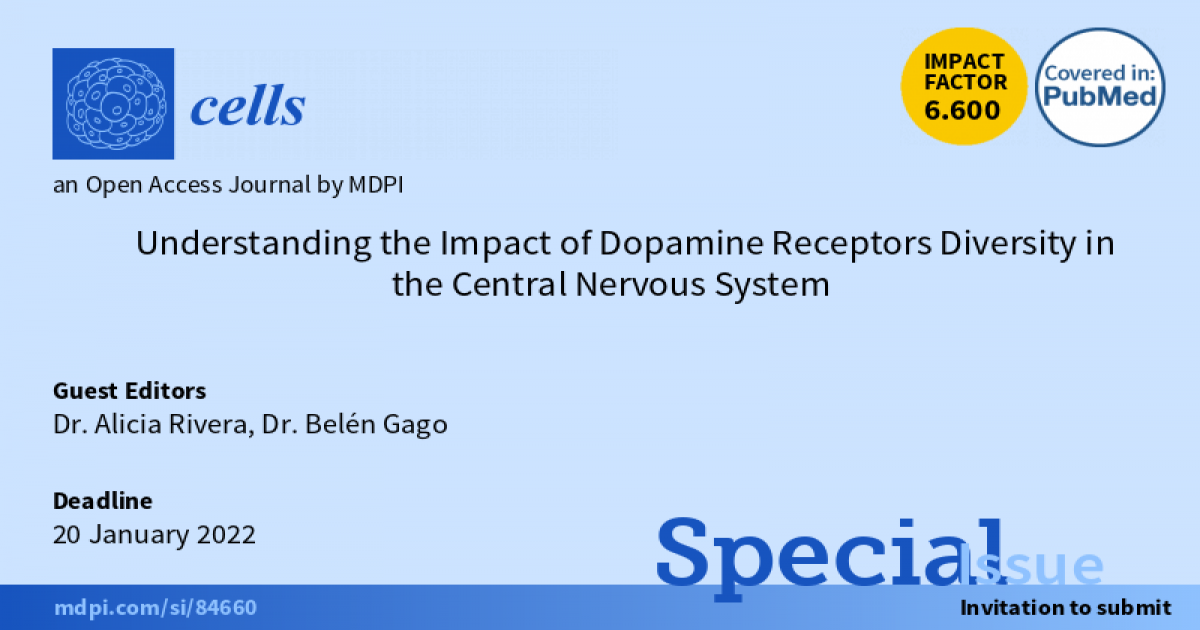- 5.2Impact Factor
- 10.5CiteScore
- 16 daysTime to First Decision
Understanding the Impact of Dopamine Receptors Diversity in the Central Nervous System
This special issue belongs to the section “Cells of the Nervous System“.
Special Issue Information
Dear Colleagues,
The neurotransmitter dopamine interacts with five types of dopamine receptors (D1R–D5R) to regulate a great variety of functions in the brain, including learning, motivation, and movement. These dopamine receptors belong to the superfamily of G protein-coupled receptors and have been classified in two families (D1-like and D2-like) according to their pharmacological and biochemical properties. Dysfunction of dopamine neurotransmission and its receptors leads to several neurological disorders such as Parkinson’s and Huntington’s diseases, addiction, and attention deficit/hyperactivity disorder. Since the cloning of the dopamine receptors in the 1990s, numerous studies have been conducted to elucidate the specific function of each of them. In addition, research on dopamine receptors has also focused on their ability to form homo- and heteroreceptor complexes, which significantly increase the variety and complexity of the integrative mechanisms of dopamine signal.
The aim of this Topical Collection is to compile research and review articles studying the molecular biology, pharmacology, and function of dopamine receptors, especially those less studied, i.e., D3R, D4R, and D5R. Articles on other important aspects of dopamine homo- and heteroreceptor complexes relevant to both health and neurological disorders are also welcome.
Dr. Alicia Rivera
Dr. Belén Gago
Collection Editors
Manuscript Submission Information
Manuscripts should be submitted online at www.mdpi.com by registering and logging in to this website. Once you are registered, click here to go to the submission form. Manuscripts can be submitted until the deadline. All submissions that pass pre-check are peer-reviewed. Accepted papers will be published continuously in the journal (as soon as accepted) and will be listed together on the special issue website. Research articles, review articles as well as short communications are invited. For planned papers, a title and short abstract (about 100 words) can be sent to the Editorial Office for announcement on this website.
Submitted manuscripts should not have been published previously, nor be under consideration for publication elsewhere (except conference proceedings papers). All manuscripts are thoroughly refereed through a single-blind peer-review process. A guide for authors and other relevant information for submission of manuscripts is available on the Instructions for Authors page. Cells is an international peer-reviewed open access semimonthly journal published by MDPI.
Please visit the Instructions for Authors page before submitting a manuscript. The Article Processing Charge (APC) for publication in this open access journal is 2700 CHF (Swiss Francs). Submitted papers should be well formatted and use good English. Authors may use MDPI's English editing service prior to publication or during author revisions.
Keywords
- Dopamine
- dopamine receptors
- dopamine heteroreceptor complexes
- Parkinson’s disease, addiction, dopaminergic disease
- basal ganglia, limbic circuit
- learning
- neuroplasticity

Benefits of Publishing in a Special Issue
- Ease of navigation: Grouping papers by topic helps scholars navigate broad scope journals more efficiently.
- Greater discoverability: Special Issues support the reach and impact of scientific research. Articles in Special Issues are more discoverable and cited more frequently.
- Expansion of research network: Special Issues facilitate connections among authors, fostering scientific collaborations.
- External promotion: Articles in Special Issues are often promoted through the journal's social media, increasing their visibility.
- e-Book format: Special Issues with more than 10 articles can be published as dedicated e-books, ensuring wide and rapid dissemination.

